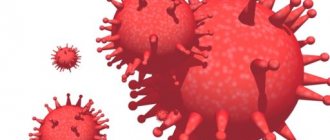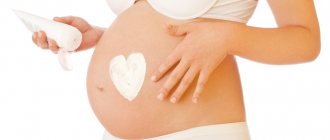| Appointment with a dermatologist at the clinic. Call a dermatologist at home. | Reception is strictly by appointment, make an appointment by phone: +7 | Prices for services | Reviews about the clinic |
Skin itching during pregnancy worries many women. It can have different localization and severity, appears at different times, but most often in the second and third trimesters.
It should be understood that itchy skin is not a disease, but only a reaction to some external or internal irritant. The reasons can be very different, both natural and harmless, and quite serious. Therefore, it cannot be ignored; in such cases, a consultation with a dermatologist is required, and, if necessary, an examination.
Make an appointment with a dermatologist by phone or by filling out the online form
| Select a clinic | Skin rash | Dermatologist | Dermatologist at home |
Answers to frequently asked questions about itchy skin:
- Which doctor treats itchy skin?
- What organs are affected by skin itching?
- Why is itchy skin dangerous?
- What tests should be taken for itchy skin?
- What diet is needed for itchy skin?
- What diseases does itchy skin indicate?
- Itchy skin for no apparent reason?
- What parasites cause itchy skin?
- What microorganisms cause itchy skin?
- How to get rid of itchy skin?
- Should a patient with itchy skin be isolated?
- Skin itching due to gastrointestinal diseases?
- What are the main causes of itchy skin?
- How to distinguish allergic itching from parasitic itching?
- How to prepare for an appointment with a dermatologist?
- How to get checked for skin diseases?
- What diseases does a dermatologist treat?
- What tests should be taken by a dermatologist?
- What diagnostics can a dermatologist perform in the clinic?
- Where to go with a skin disease?
The most likely causes of itchy skin during pregnancy
There are several main reasons that most often cause itchy skin during pregnancy:
- Abdominal enlargement and breast growth
. Most often, expectant mothers complain that their skin on their stomach and chest is itchy and itchy. This is explained simply: due to rapid growth, the skin does not have time to stretch and can become covered with microscopic cracks. Getting rid of it is relatively simple: regularly rub hypoallergenic oil or moisturizer into the skin. - Allergy
. Pregnancy is associated with a number of changes in the functioning of the body. And one of them is an increased likelihood of allergic reactions. An allergy can be to anything: cosmetics, dust, food, medicine. - Activation of diseases
. During the restructuring of the body, the level of immunity temporarily decreases, which can lead to the activation of chronic diseases, as well as infections, including fungal infections, which were previously restrained by the body’s own defense mechanisms. - Cholestasis.
In approximately 1% of pregnant women, the phenomenon of cholestasis occurs, in which the mechanism of bile utilization is disrupted. Its salts can accumulate in body tissues, causing itchy skin. This phenomenon is quite dangerous because it can lead to problems with pregnancy. In this case, consultation with a gastroenterologist is required. - Stress
. In some cases, skin itching is of a psychogenic nature and is a consequence of stress, anxiety or mental tension. In such cases, herbal sedatives or teas are selected.
Thus, there are several main reasons for the appearance of itching during pregnancy, but it is possible to say which one is responsible for it in each specific situation only after an examination.
Useful information on the topic of itchy skin:
- Dermatologist
- Itching due to skin diseases
- Itchy skin without manifestations on the skin
- Itchy skin in the groin
- Itchy skin on legs
- Itchy skin on hands
- Itchy skin on the back
- Itchy skin during pregnancy
- Itchy skin in liver diseases
- Itchy skin in children
- Itchy skin in the elderly
- Treatment of itchy skin
- Night skin itching
- Causes of itchy skin
There are three main categories of pregnancy-related skin conditions: (1) benign skin conditions caused by natural hormonal changes, (2) pre-existing skin conditions whose course changes during pregnancy, and (3) pregnancy-specific dermatoses. In some cases, these categories may overlap.
KEY RECOMMENDATIONS FOR PRACTICAL APPLICATION
| Clinical guidelines | Level of evidence | SOURCES |
| Highly effective, broad-spectrum sunscreens (UVA and UVB filters) can prevent melasma. | C | , |
| Severe epidermal melasma can be treated after childbirth with combinations of topical tretinoin (Retin-A), hydroquinone (Eldoquin Forte), and corticosteroids. | B | , |
| Ursodeoxycholic acid (ursodiol [Actigall]) effectively reduces pruritus and serum bile acid levels in patients with severe intrahepatic cholestasis during pregnancy. | B | , |
| Patients with intrahepatic cholestasis during pregnancy, impetigo herpetiformis and gestational pemphigoid should be monitored until delivery. | C | , |
Benign skin diseases
Skin conditions caused by natural hormonal changes during pregnancy include striae gravidarum, hyperpigmentation, and changes in hair, nails, and blood vessels.
STRIPS IN PREGNANT
Striae gravidarum (stretch marks) occur in 90 percent of pregnant women by the third trimester (Figure 1) (1, 2). Striae appear as pink-purple atrophic lines or stripes on the abdomen, buttocks, breasts, thighs, or arms. They are more common in young women, women with large pregnancies, and women with higher body weights (3).
Women with dark skin who have a history of stretch marks on the chest or thighs, or a family history of stretch marks of pregnancy, are also at higher risk (4).
The cause of striae is multifactorial and includes physical factors (eg, actual stretching of the skin) and hormonal factors (eg, the effect of adrenal hormones, estrogen and relaxin on the elastin fibers of the dermis).
Numerous creams, emollients, and oils (eg, vitamin E cream, cocoa butter, aloe vera lotion, olive oil) are used to prevent stretch marks; however, there is no evidence that these treatments are effective. Limited evidence suggests that two topical medications may help prevent striae (5).
One contains Centella Asiatica extract plus alpha-tocopherol and collagen and elastin hydrolysates. Another product contains tocopherol, essential fatty acids, panthenol, hyaluronic acid, elastin and menthol.
However, none of these drugs are widely available, and the safety of using centella asiatica during pregnancy and the components responsible for their effectiveness are unclear (6).
Further research is needed before these treatments and commonly used creams and emollients can be recommended for widespread use.
Most stretch marks regress to pale or flesh-colored lines and improve after childbirth, although they usually do not disappear completely. Treatment is nonspecific and there is a limited evidence base.
Postpartum treatment includes topical tretinoin therapy (Retin-A) or oral tretinoin therapy (Vesanoid) (U.S. Food and Drug Administration pregnancy categories C and D, respectively; safety unknown in breastfeeding women) and laser therapy (585 nm, pulsed dye laser) (7, 8).
HYPERPIGMENTATION
Almost all women experience some form of hyperpigmentation during pregnancy. These changes are usually more pronounced in women with darker skin.
The areas most commonly affected are the nipple areola, armpits, and genitals, although scars and nevi may also become pigmented. The linea nigra is a line that often forms when the linea alba darkens during pregnancy.
Melasma (chloasma or mask of pregnancy) may be the most cosmetically problematic skin condition associated with pregnancy (Figure 2). Up to 70 percent of pregnant women have this condition (1), and it can also occur in women taking oral contraceptives.
Exposure to sunlight and other types of ultraviolet radiation worsens melasma; Therefore, using highly effective broad-spectrum sunscreens (against UVA and UVA) and avoiding overexposure to sunlight may prevent the development or worsening of melasma (1, 2).
Although no specific treatment is prescribed during pregnancy, doctors can reassure patients that melasma in most cases goes away after childbirth. However, it may not resolve completely and may recur in future pregnancies or with the use of oral contraceptives (1, 2).
Severe postpartum epidermal melasma is usually treated with combinations of topical tretinoin, hydroquinone (Eldoquin Forte), and corticosteroids (9, 10).
CHANGES IN HAIR AND NAILS
An increase or decrease in hair growth is common during pregnancy (1, 2, 11). Many women have manifestations of hirsutism on the face, limbs and back, caused by endocrine changes during pregnancy.
Hirsutism usually resolves after childbirth, although cosmetic correction may be considered if the condition persists. Pregnant women may also notice a slight thickening of the hair on their scalp. This is caused by the prolonged active (anagen) phase of hair growth.
After childbirth, scalp hair enters a long resting phase (telogen) of hair growth and increased shedding (telogen hair loss) occurs, which can continue for several months or more than a year after pregnancy (12).
A few women prone to androgenetic alopecia may notice frontoparietal hair loss, which may not go away after pregnancy.
Nails usually grow faster during pregnancy. Pregnant women may experience increased fragility, transverse grooves, onycholysis, and subungual hyperkeratosis (1, 2, 11). Most of these conditions resolve after delivery, and doctors can explain this to patients and recommend adequate nail care.
VASCULAR CHANGES
Natural changes in estrogen production during pregnancy can cause dilation, instability, proliferation, and blockage of blood vessels. Most of these vascular changes resolve after delivery (1).
Spider telangiectasias (spider nevi or spider angiomas) occur in approximately two-thirds of pregnant women with light skin phototypes and 10 percent of pregnant women with dark skin phototypes, mainly on the face, neck and arms. This condition most often occurs in the first and second trimesters of pregnancy (1, 2, 11).
Palmar erythema occurs in approximately two thirds of pregnant women with light skin phototypes and up to one third of pregnant women with dark skin phototypes. Subcutaneous, vulvar, or hemorrhoidal varicose veins occur in approximately 40 percent of pregnant women (1, 2, 11).
Vascular changes combined with increased blood volume can cause increased “outflow,” leading to persistent swelling of the face, eyelids, and extremities in up to half of pregnant women (1, 11).
Increased blood flow and pelvic vascular instability can cause vaginal erythema (Chadwick's sign) and a bluish discoloration of the cervix (Goodell's sign) (1).
Vasomotor disturbances can also cause facial flushing; dermatographism; sensations of heat and cold; and manifestations of marbled skin, a condition characterized by a bluish tint to the skin due to an excessive reaction to cold (2).
All pregnant women experience hyperemia and swelling of the gums, which can cause gingivitis and bleeding, especially in the third trimester (1, 11).
Pyogenic granulomas may appear late in the first trimester or in the second trimester as dark red or purple nodules on the gums or, less commonly, on other areas of the skin.
In most patients, observation is advisable because these lesions usually regress after delivery. However, if bleeding occurs, surgical treatment and possible excision may be indicated (1, 2, 11).
Previously existing skin diseases
Pre-existing skin conditions (eg, atopic dermatitis; psoriasis; candidiasis and other fungal infections; skin tumors, including malignant melanoma) may change during pregnancy.
Atopic dermatitis and psoriasis may worsen or improve during pregnancy. Atopic eruptions may be associated with prurigo gravidarum and usually worsen over time but may improve during pregnancy (13).
Psoriasis often improves as it progresses. Fungal infections usually require a longer course of treatment during pregnancy (14).
Soft tissue fibroids can occur on the face, neck, upper chest, and under the breasts during late pregnancy. These fibroids usually disappear after childbirth (1).
The impact of pregnancy on the development and prognosis of malignant melanoma has been widely debated; however, a recent retrospective cohort study of pregnant women with melanoma provided no evidence that pregnancy affects survival (16).
Dermatological diseases typical for pregnant women
True dermatoses of pregnancy (Table 1) (17, 23) include pruritic urticarial papules and plaques of pregnancy (PUPPP), pruritus of pregnancy, intrahepatic cholestasis of pregnancy, pemphigoid of pregnancy, impetigo herpetiformis, and pruritic folliculitis of pregnancy.
TABLE 1 . Dermatological diseases characteristic of pregnancy
| DISEASE | MANIFESTATIONS | RISK FOR PREGNANCY | treatment |
| Pruritic urticarial papules and plaques of pregnancy (17) | Severely pruritic urticarial plaques and papules with or without erythematous macules, papules and vesicles; the rash first appears on the abdomen, often along stretch marks and sometimes affects the limbs; the face is usually not affected | Impact not established | Oral antihistamines and topical corticosteroids for itching; systemic corticosteroids for severe symptoms |
| Prurigo of pregnancy (1) | Erythematous papules and nodules on the extensor surfaces of the extremities | Impact not established | Moderate-strength topical corticosteroids and oral antihistamines |
| Intrahepatic cholestasis of pregnancy (1) | Excoriation from scratching; localization is nonspecific | Risk of preterm birth, meconium-stained amniotic fluid, intrauterine fetal death | Oral antihistamines for mild itching; ursodeoxycholic acid (ursodiol [Actigall]) in more severe cases |
| Pemphigoid of pregnancy (20) | Pruritic papules, plaques and vesicles developing into generalized vesicles or blisters; initial periumbilical lesions may generalize, although the face, scalp, and mucous membranes are usually spared | Newborns may have urticarial, vesicular, or bullous eruptions; risk of preterm birth and small gestational age fetuses | Oral antihistamines and topical corticosteroids for mild cases; systemic oral corticosteroids for severe cases |
| Impetigo herpetiformis (22) | Round, arcuate or polycyclic spots covered with small painful pustules of a herpetiform arrangement; most often appears on the thighs and groin, but the rash can aggregate and spread to the trunk and limbs; the face, arms and legs are not affected; mucous membranes may be involved | Reports of increased fetal involvement | Systemic corticosteroids; antibiotics for secondary infected lesions |
| Itchy folliculitis in pregnancy | Erythematous follicular papules and sterile pustules on the abdomen, arms, chest and back | Impact not established | Topical corticosteroids, topical benzoyl peroxide (Benzac), or ultraviolet B light therapy |
PUPPP
PUPPP (Figure 3) is the most common pregnancy-specific dermatosis, occurring in one in 130–300 pregnant women (1).
The PUPPP-associated rash, characterized by intense itching, develops in the third trimester and usually appears first on the abdomen, often along stretch marks (17).
This disorder is more common in first pregnancies and multiple pregnancies, and familial cases have also been reported (18).
Despite its frequency, the etiology of PUPPP remains unclear. A relationship has been suggested between this disease and disturbances in the interaction between the maternal immune system and fetal tissues (24).
The increased incidence in women with multiple pregnancies suggests that skin stretching may play a role in triggering an immune-mediated reaction. Histopathological findings are nonspecific (18).
There is no specific treatment for PUPPP and it is not associated with adverse pregnancy outcomes.
Antihistamines and topical steroids can be used to treat itching, and systemic corticosteroids can be used for severe itching (18). The rash usually goes away within one to two weeks after delivery.
Prurigo of pregnant women
Prurigo in pregnancy (Fig. 4.) occurs in approximately one in 300 pregnant women and is recorded in all trimesters (1). It is not uncommon for a pregnant woman to experience prolonged itching that persists for weeks or months after giving birth (1).
The cause of this disease is unclear, and there are no significant adverse effects on the mother or fetus. An association with intrahepatic cholestasis during pregnancy or a history of atopy has been suggested (18). Mild-strength topical steroids and oral antihistamines may provide symptomatic relief.
INTRAHEPATIC CHOLESTASIS IN PREGNANCY
Intrahepatic cholestasis of pregnancy has historically been called pruritus of pregnancy because its classic presentation is severe itching in the third trimester. Intrahepatic cholestasis of pregnancy occurs in one in 146 to 1293 pregnant women in the United States (1).
The diagnosis is based on the clinical picture and history: itching with or without jaundice, the absence of primary elements of a skin rash and laboratory markers of cholestasis. This condition usually resolves after childbirth (1, 18, 19).
Laboratory markers include elevated serum bile acid levels (4.08 μg per mL [10 μmol per L] or more) and alkaline phosphatase levels with or without elevated bilirubin levels (25).
However, alkaline phosphatase levels are typically elevated in pregnant women, limiting the value of this test (19).
Aspartate aminotransferase and alanaminotransferase levels and other liver function tests may be slightly altered. Cholestasis and jaundice in patients with severe or prolonged intrahepatic cholestasis during pregnancy may cause vitamin K deficiency and coagulopathy (18).
The etiology of intrahepatic cholestasis during pregnancy remains controversial. Family history of the disease is common, and there is an association with the presence of human leukocyte antigen-A31 (HLA-A31) and HLA-B8 (1, 18).
This condition tends to recur in subsequent pregnancies (1). Patients may have a family history of gallstone disease and a higher risk of gallstone formation (25, 26).
This condition is associated with a higher risk of preterm birth and rupture of meconium-stained fluid and fetal death.
A prospective cohort study demonstrated a correlation between bile acid levels and fetal complications, with a statistically significant increase in adverse fetal outcomes reported in patients with bile acid levels of 16.34 μg per mL (40 μmol per L) or more (25).
For patients with mild itching, oral antihistamines may be prescribed. Patients with more severe cases require ursodeoxycholic acid (ursodiol [Actigall]) to relieve pruritus and reduce cholestasis while reducing the risk of adverse fetal outcomes (18, 27).
Current data do not support the effectiveness of therapy with S-adenosylmethionine, anion exchange resins (eg, cholestyramine [Questran]), or corticosteroids (18, 28).
Patients should undergo in-depth prenatal care at diagnosis, and some recommendations recommend delivery before 38 weeks of pregnancy. The effect of early delivery on perinatal complications has not been proven (29).
PEMPHIGOID IN PREGNANT
Gestational pemphigoid (Figure 5), sometimes called gestational herpes, is an autoimmune skin disease that occurs in one in 50,000 mid- to late-term pregnancies (20).
Pemphigoid gravidarum is associated with the presence of HLA-DR3 and HLA-DR4 and is rarely associated with molar pregnancy and choriocarcinoma (18, 21). Patients with a history of this disease have an increased risk of other autoimmune diseases (eg, Graves' disease) (30).
The disease can occur in different ways, although its course usually improves in late pregnancy with exacerbations in the immediate postpartum period. Exacerbations have been associated with oral contraceptive use and are common in subsequent pregnancies (18).
Immunodiagnostic studies reveal characteristic deposits of complement C3 along the dermoepidermal junction (30). The risk to the fetus has not been confirmed, although immunoglobulin G autoantibodies cross the placenta, and 5 to 10 percent of newborns have urticarial, vesicular, or bullous lesions (30).
Mild placental insufficiency has been associated with preterm birth and small gestational age neonates. Therefore, antenatal care should be considered (22).
Patients with mild forms of pemphigoid of pregnancy may respond to oral antihistamines and systemic topical corticosteroids, while patients with more severe symptoms may require oral corticosteroids.
HERPETIFORM IMPETIGO
Impetigo herpetiformis (Figure 6), a form of pustular psoriasis, is a rare skin disease that appears in the second half of pregnancy. Whether this disorder is specific to pregnancy or simply exacerbated by it remains controversial (1).
Systemic signs and symptoms of impetigo herpetiformis include nausea, vomiting, diarrhea, fever, chills, and lymphadenopathy. There is usually no itching. Complications (eg, secondary infection, septicemia, hyperparathyroidism with hypocalcemia, hypoalbuminemia) may occur (1).
Treatment of impetigo herpetiformis includes systemic corticosteroids and antibiotics to treat secondary infected lesions. Prednisolone may be required at a dose of 15 to 30 mg to 50 to 60 mg per day, followed by a slow dose reduction (1, 22, 23).
The disease usually resolves after childbirth, although it may recur during subsequent pregnancies. The degree of risk to the fetus is somewhat controversial; however, an increase in fetal morbidity has been reported, suggesting the need for increased prenatal care (22).
ITCHY FOLLICULITIS OF PREGNANCY
Pruritic folliculitis of pregnancy occurs in the second and third trimesters and manifests as erythematous follicular papules and sterile pustules.
Contrary to its name, itching is not the main symptom. Spontaneous resolution occurs after childbirth. This condition is likely underdiagnosed because it is often misdiagnosed as bacterial folliculitis (18).
The etiology of pruritic folliculitis of pregnancy is unclear, and there are no reports of adverse fetal outcomes clearly associated with this condition. Treatment includes topical corticosteroids, topical benzoyl peroxide (Benzac), and ultraviolet B therapy (1).
How to relieve itchy skin?
Expectant mothers are advised to follow tips that will help relieve itchy skin during pregnancy:
- Wear clothes only from natural fabrics.
- Select hypoallergenic cosmetics or products from the line for pregnant women.
- Do not take very hot showers as they dry out and irritate the skin.
- You can relieve the itching with a cool shower.
- After bathing, it is useful to lubricate the skin with moisturizers.
- Unfamiliar foods should be introduced into the diet with caution.
But the main thing is to consult a doctor promptly if you suspect any disease.
Methods for diagnosing skin diseases:
- Diagnosis of skin diseases
- Diagnosis of skin diseases at home
- Diagnosis of allergic skin diseases
- Diagnosis of bacterial skin diseases
- Diagnosis of viral skin diseases
- Diagnosis of hair diseases
- Diagnosis of nail diseases
- Diagnosis of skin tumors
- Skin scraping
- Blisters on the skin
- Dermatoscopy
- Demodex tests
- Diagnosis of sexually transmitted infections
- Mushroom tests
- Skin scraping
Accurate signs of pregnancy:
- The hCG pregnancy test is the most accurate sign of pregnancy.
- An ultrasound of the fetus at 7-12 weeks of pregnancy will give an accurate guarantee of the presence of pregnancy.
- The fetal heartbeat can be heard from the 12th week of pregnancy. The normal fetal heart rate is 120 – 160 beats per minute.
- Feeling the fetus is available in late pregnancy. Obstetricians can use it to determine the position of the fetus in the womb.
- Fetal movement . As a rule, it begins at 20 weeks of pregnancy.
If you see many of the first signs of pregnancy described, consult your doctor to accurately determine your situation. We hope you become a mother soon! Health to you and your baby!
What to do if you experience itchy skin?
During pregnancy, a woman should be especially attentive to her condition, and skin itching is one of the symptoms that requires consultation with a doctor, in this case a dermatologist.
In such cases, you should not select treatment measures on your own, because they can affect the course of pregnancy. But if a visit to the clinic is difficult for some reason, a dermatologist can be called to your home
. And the “Your Doctor” website will tell you which clinics offer the necessary services and help you submit an application.
Common symptoms and manipulations in dermatology:
- Skin rashes
- Calling a dermatologist to your home
- Itching in the urethra
- Itchy skin
- Skin rash
- Prevention of casual sex
- Skin neoplasms
- Pyoderma
- Pityriasis rosea
- Streptoderma
- Scabies
- Peeling skin
- Fungal infections
- Skin infection
- Pus on the skin
- Blisters on the skin
- Papillomas on the foreskin
- Sexually transmitted diseases
- Skin structure
This article is posted for educational purposes only and does not constitute scientific material or professional medical advice.
Author:
Kasabov Vadim Vladimirovich Dermatovenerologist
Back to section









